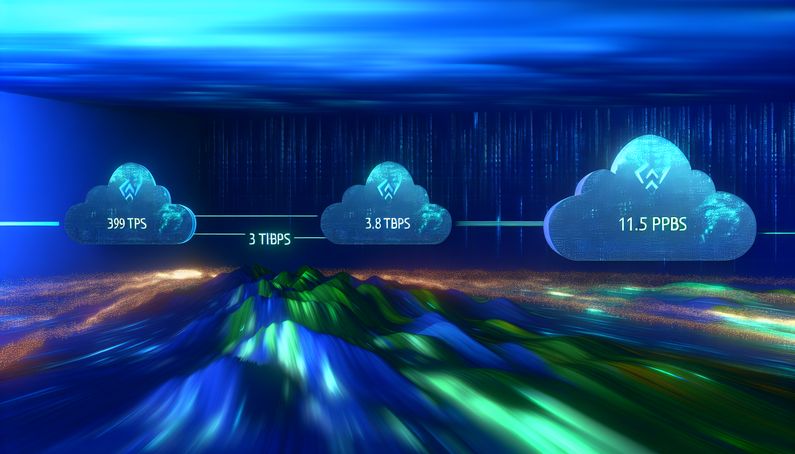
The Evolution of DDoS Attacks: From 3.8 Tbps to 11.5 Tbps
Distributed Denial-of-Service (DDoS) attacks have become a formidable challenge in the cybersecurity landscape, with attackers constantly pushing the boundaries of scale and sophistication. A significant leap in this ongoing battle was marked by Cloudflare’s mitigation of a colossal 11.5 Tbps DDoS attack in September 2025. This attack, originating from compromised resources on Google Cloud Platform, highlights the dual role of cloud platforms as both a defense mechanism and a potential launchpad for large-scale assaults. Jumping from 3.8 Tbps to 11.5 Tbps is like going from a garden hose to a fire hydrant, underscoring the rapid escalation in attack capabilities (Cloudflare).
The Evolution of DDoS Attacks: From 3.8 Tbps to 11.5 Tbps
Historical Context and Initial Records
Distributed Denial-of-Service (DDoS) attacks have evolved significantly over the years, with attackers continuously enhancing their techniques to overwhelm targets with massive volumes of data. A notable milestone in the history of DDoS attacks was recorded in October 2024 when Cloudflare successfully mitigated an attack that peaked at 3.8 terabits per second (Tbps). This attack was part of a broader campaign targeting various industries, including financial services and telecommunications, and marked a new record for volumetric DDoS attacks at the time.
Technological Advancements and Attack Amplification
The increase in DDoS attack sizes can be attributed to several technological advancements and the exploitation of vulnerabilities in network protocols. Attackers have leveraged amplification techniques, such as UDP reflection and SSDP amplification, to multiply the volume of traffic directed at a target. Imagine shouting into a canyon and hearing your voice echo back much louder—that’s similar to how these techniques work. The Mirai botnet was one of the first to exploit Internet of Things (IoT) devices, demonstrating the potential for massive botnets to generate significant volumetric traffic.
The Role of Cloud Platforms in DDoS Attacks
Cloud platforms have played a dual role in the evolution of DDoS attacks. While they offer robust infrastructure and security measures to mitigate attacks, they can also be exploited by attackers to launch large-scale assaults. The record-breaking 11.5 Tbps DDoS attack that Cloudflare mitigated in September 2025 originated primarily from compromised resources on Google Cloud Platform. This attack was characterized as a hyper-volumetric UDP flood, setting a new industry high for network bandwidth consumed by malicious traffic.
Increasing Frequency and Magnitude of DDoS Attacks
The frequency and magnitude of DDoS attacks have increased significantly over the years. Cloudflare’s 2025 Q1 DDoS Report revealed a 198% quarter-over-quarter increase and a 358% year-over-year jump in the number of attacks mitigated in 2024 (Bleeping Computer). The company reported mitigating a total of 21.3 million DDoS attacks targeting its customers and its own infrastructure. This surge in attack volume highlights the growing threat landscape and the need for continuous advancements in defense mechanisms.
Defensive Strategies and Technological Innovations
In response to the escalating threat of DDoS attacks, companies like Cloudflare have developed advanced defense strategies and technologies. These include real-time traffic analysis, machine learning algorithms to detect and mitigate attacks, and the deployment of global networks to absorb and neutralize malicious traffic. Cloudflare’s ability to autonomously block hundreds of hyper-volumetric DDoS attacks, including the 11.5 Tbps assault, demonstrates the effectiveness of these measures (The Nimble Nerd).
Future Trends and Challenges
As DDoS attacks continue to evolve, new challenges and trends are emerging. Attackers are increasingly targeting specific industries and leveraging sophisticated techniques to bypass traditional defense mechanisms. The rise of IoT devices and the proliferation of cloud services present new opportunities for attackers to exploit vulnerabilities and launch large-scale assaults. To counter these threats, organizations must invest in robust security measures, stay informed about the latest attack trends, and collaborate with industry partners to share intelligence and develop effective defense strategies.
Conclusion
The evolution of DDoS attacks from 3.8 Tbps to 11.5 Tbps underscores the dynamic nature of the threat landscape and the continuous arms race between attackers and defenders. As attack sizes and frequencies increase, organizations must remain vigilant and proactive in their defense strategies to protect their infrastructure and ensure the availability of critical services.
Final Thoughts
The journey from 3.8 Tbps to 11.5 Tbps in DDoS attack sizes illustrates the relentless arms race between cyber attackers and defenders. As attackers harness technological advancements and exploit vulnerabilities in cloud platforms, the need for robust defense strategies becomes ever more critical. Cloudflare’s success in mitigating these hyper-volumetric attacks demonstrates the effectiveness of cutting-edge technologies like real-time traffic analysis and machine learning (The Nimble Nerd). However, as the threat landscape continues to evolve, organizations must remain vigilant, investing in innovative security measures and fostering collaboration to protect against future threats.
References
- Breached Company. (2024). Record-breaking 3.8 Tbps distributed denial-of-service (DDoS) attack. https://breached.company/record-breaking-3-8-tbps-distributed-denial-of-service-ddos-attack/
- Cybersecurity News. (2025). Record-breaking DDoS attack: 11.5 Tbps. https://cybersecuritynews.com/record-breaking-ddos-attack-11-5-tbps/
- The Nimble Nerd. (2025). Cloudflare’s blockbuster DDoS defense: Smashing records with 11.5 Tbps block. https://thenimblenerd.com/article/cloudflares-blockbuster-ddos-defense-smashing-records-with-11-5-tbps-block/
- Bleeping Computer. (2025). Cloudflare blocks record-breaking 11.5 Tbps DDoS attack. https://www.bleepingcomputer.com/news/security/cloudflare-blocks-record-breaking-115-tbps-ddos-attack/



